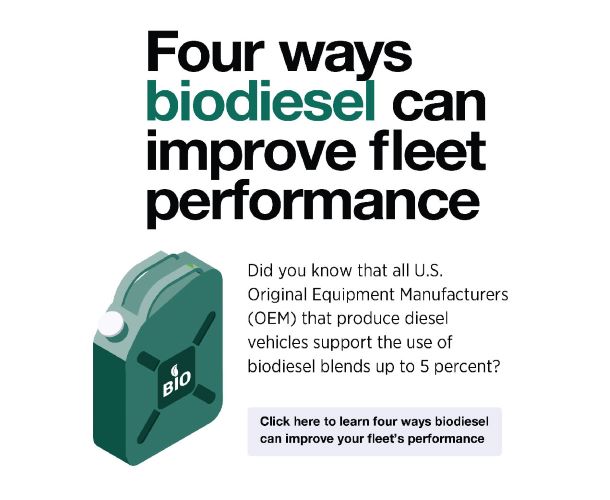Fuel Solutions and Engine Technologies Using Biomass-Based Fuels
If your company is looking to lower lifecycle carbon emissions for your fleet, incorporating renewable fuels is one of the simplest and fastest ways to help you reach your targets. Whether you are in the trucking, marine, mining, rail or power generation business, your lower carbon journey will likely include biomass-based lower carbon fuel solutions to power your diesel engines.

Today, companies are focused on the environment and demonstrating scalable, lower carbon intensity business practices. They are looking at how lower carbon fuel solutions can help their companies reach their lifecycle carbon emissions targets quickly and help gain an edge in the marketplace. As the largest contributor to greenhouse gas emissions in the United States, commercial transportation plays a critical role in making this shift.1
Early adopters may be eager to integrate new, emerging technologies, while others may want to gain insights on strategies for incorporating additional biofuel into their existing infrastructure.
We have assembled a team of experts to provide an in-depth look at internal combustion engine (ICE) technologies and how renewable fuels, such as biodiesel and renewable diesel can immediately provide lower carbon solutions.
Fuel Solutions and Engine Technology
Recently, Chevron and Cummins Inc. announced a collaborative plan to improve fleets’ access to alternative and renewable fuels and fuel infrastructure. Experts from Chevron and Cummins agree that biodiesel can help lower lifecycle carbon emissions and can improve engine performance. Biodiesel is also a standard offering in Cummins North American on-highway engines for past, present and even future products. Biodiesel blends up to B20 have been approved for use in Cummins engines since 2007.
Learn More
The Role of Renewable Diesel
Renewable diesel is made from the same renewable resources as biodiesel but uses a different production process. The result is a renewable, lower carbon fuel that is more like petroleum diesel and meets the same ASTM D975 specification.
Renewable diesel blends well with high-quality biodiesel and blending the two fuels captures some of the best properties of each: high Cetane for better combustion, increased lubricity, lower lifecycle carbon emissions and an excellent cloud point. When blended, it’s essentially a drop-in fuel that works just like traditional diesel fuel with comparable engine performance.
Renewable diesel delivers strong engine performance and has up to 85% less sulfur than Ultra Low Sulfur Diesel (ULSD). As lower carbon air regulations and targets become more common, this fuel will continue to grow in popularity.
Learn More
The Role of Biodiesel
What makes biodiesel different than petroleum diesel? Biodiesel is made from a variety of feedstocks including renewable resources that are largely plant-based, with their energy coming from the sun instead of fossil fuels.
Fleets in many segments are running millions of miles a year using biodiesel. One of the reasons fleets use biodiesel is because it’s considered a convenient, drop-in fuel. That means it can be used in most existing diesel vehicles and fueling infrastructure, giving diesel fleets a solution for lowering lifecycle carbon emissions quickly using their existing equipment.
Learn More
Higher blends of biodiesel can accelerate lower carbon intensity
If your company is looking to quickly lower lifecycle carbon emissions in your fleet, you should consider using higher blends of biodiesel.
Incorporating higher blends of biodiesel is one way to accelerate your lower carbon journey.
Over the last decade, the quality of biodiesel has improved and now enables safely blending above B20. Advantages of higher blends include greater reduction of carbon intensity and improved engine emissions.
Learn More
Reducing lifecycle carbon emissions with biomass-based diesel fuels
One of the quickest and most effective ways to help the transportation industry work toward their lower carbon targets is to incorporate biodiesel and renewable diesel. Both fuel solutions can be incorporated into existing infrastructure and can help reduce greenhouse gas emissions right away.
Compared to petroleum diesel, biodiesel and renewable diesel may reduce carbon emissions by up to 100% for fossil carbon.2 Biodiesel can also reduce total hydrocarbons by 70%, and renewable diesel can do so by up to 40%.3 The carbon intensity (CI) score of biodiesel and renewable diesel have also been consistently lower than LNG and hydrogen.4
Learn More
1. https://www.epa.gov/greenvehicles/fast-facts-transportation-greenhouse-gas-emissions
2. Product is produced from renewable oils and fats. Methanol used to make biodiesel and hydrogen used to make renewable diesel and SAF are typically made from conventional natural gas but can be produced from renewable resources.
3. CARB Assessment of the Emissions from the Use of Biodiesel as a Motor Vehicle Fuel in California "Biodiesel Characterization and NOx Mitigation Study." Durbin (2011)
4. https://ww2.arb.ca.gov/resources/documents/low-carbon-fuel-standard-reporting-tool-quarterly-summaries